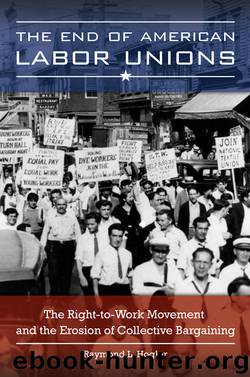End of American Labor Unions by Hogler Raymond L.;

Author:Hogler, Raymond L.;
Language: eng
Format: epub
Publisher: ABC-CLIO, LLC
Published: 2015-01-09T16:00:00+00:00
4
Evolving Labor Policy: From World War II into the Obama Administration
Confident that the Supreme Court would dispatch the National Labor Relations Act in the doctrinal mode it had used to nullify earlier New Deal legislation, business interests continued to ignore the law and the National Labor Relations Board. A member of the nonunion “little steel” group, the Jones & Laughlin Steel Company, resisted organizing attempts in 1936 by the Steelworkers’ Organizing Committee (SWOC) under John L. Lewis with the same panache it had successfully deployed in past efforts, namely threatening, coercing, and discharging union sympathizers. At the urging of Lewis and Philip Murray, the Board pursued unfair labor practice charges against the company, and the case eventually reached the Supreme Court. Jones & Laughlin’s respected legal representative, Reed, Clay, Shaw, & Smith, assured the company that the only issue of importance was the constitutional question of federal power.1 When legal maneuvering failed and the Court upheld the NLRA as an exercise of its power to regulate interstate commerce, business aggressively responded to the union presence. What emerged from those efforts was the right-to-work movement in its modern incarnation and its eventual apotheosis in the federal Taft-Hartley Act of 1947.
This chapter traces the origins of right to work, from the beginnings of state labor legislation in the late 1930s to the successful right-to-work legislation in Indiana and Michigan in 2012. During the period, states engaged in political battles over union security that finally came to a temporary cessation after the Idaho law in 1985 and then resumed with even greater ardor after the 2010 Congressional elections. A leading labor historian concludes that the turning point in union fortunes and the defining event in modern labor decline was the failure to unionize the South during Operation Dixie in the late 1930s and early 1940s.2 Out of that failed campaign emerged a pattern of right-to-work legislation spreading from the former slave states into the West and upper Midwest and eventually penetrating into the heartland of union power.
The regional bastions of antiunionism provided the platform for an employer strategy of competition based on wage costs. The program included overt racism that divided workers on the basis of race, color, and ethnicity to create segmented labor markets.3 In the deep South, attitudes toward race that developed during the Reconstruction period played a vital role in defeating the Congress of Industrial Organizations’ attempt to unionize southern industry in Operation Dixie.4 That failure signified an important turning point in American political development, by establishing a regional power center capable of controlling national legislation.5 The West constructed its own brand of race conflict, beginning with the dispossession of Native Americans from desirable lands, marginalization of Mexican settlers who had been in the region since Colonial times, and resistance to Asian workers imported for labor in mining and railroads.
Colorado is an instructive case regarding the evolution of labor relations. The emergence of racist and antilabor attitudes began with the genocidal tactics against the Cheyenne-Arapaho tribes in the latter nineteenth century, followed by the notorious Ludlow Massacre of 1914.
Download
This site does not store any files on its server. We only index and link to content provided by other sites. Please contact the content providers to delete copyright contents if any and email us, we'll remove relevant links or contents immediately.
Machine Learning at Scale with H2O by Gregory Keys | David Whiting(4176)
Killers of the Flower Moon by David Grann(3969)
Oathbringer (The Stormlight Archive, Book 3) by Brandon Sanderson(2875)
Will by Will Smith(2791)
Once Upon a Broken Heart by Stephanie Garber(2668)
Guns, Germs and Steel by Diamond Jared(2303)
Borders by unknow(2227)
It Starts With Us (It Ends with Us #2) by Colleen Hoover(2196)
Friends, Lovers, and the Big Terrible Thing by Matthew Perry(2117)
The Room Where It Happened by John Bolton;(2102)
The Color of Law by Richard Rothstein(1885)
The Strength In Our Scars by Bianca Sparacino(1776)
HBR's 10 Must Reads 2022 by Harvard Business Review(1776)
A Short History of War by Jeremy Black(1759)
Water Rights and the Environment in the United States by John Burch(1643)
Examples & Explanations: Administrative Law by William F. Funk & Richard H. Seamon(1601)
515945210 by Unknown(1599)
A Game of Thrones (The Illustrated Edition) by George R. R. Martin(1588)
That Every Man Be Armed by Stephen P. Halbrook(1548)
